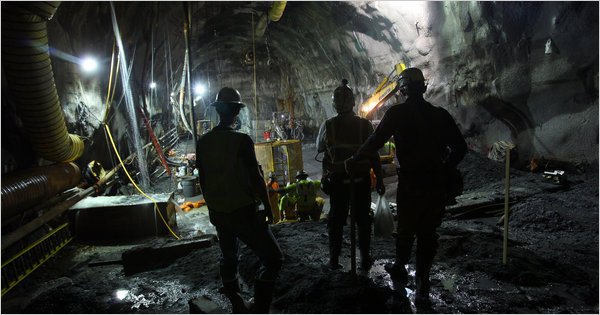
These revelations about the Roman Catholic Church just get weirder and sadder. These women are obviously psychologically frail and so passionately in search of God that manipulating them through these mind trips seems particularly awful. And this scandal, like the pedophile one, has the same strange psycho-sexual religious S&M quality to it that seems to haunt so much of the Church's relationship with the larger society.
Stephan A. Schwartz
Vatican probes group tied to scandal

This June 10, 2010 picture shows Silvia Vernudez, 37, of Venezuela, left, and Marcela De Maria y Campos, 38, of Mexico, during an interview in Rome. The life of those known as "consecrated women" is regimented down to the way they eat an orange, with silence the norm, e-mail screened and close friendships discouraged. But these women are not nuns _ they are lay members of the now-disgraced Legionaries of Christ order who dedicate their lives to the Catholic Church. Their situation has so alarmed Pope Benedict XVI that in May he ordered an extremely rare full Vatican investigation. Vernudez runs a house for consecrated women in the Philippines and was visiting the mother house in Rome, and Campos is a member of the Legionaries of Christ Regnum Christi. (AP Photo/Riccardo De Luca)
By NICOLE WINFIELD
updated 9/25/2010 8:50:09 PM ET
VATICAN CITY — It's a life regimented in excruciating detail, down to the way they eat an orange. Silence is the norm, information is limited, e-mail is screened, close friendships are discouraged and family members are kept at bay — all in the name of God's will.
Known as consecrated women, they are lay Catholics affiliated with a conservative religious order who dedicate their lives to the church, making promises of chastity, poverty and obedience similar to the vows taken by nuns.
But the cult-like conditions they endure so alarmed Pope Benedict XVI that in May he ordered an extremely rare full Vatican investigation of the obscure group, which operates in the U.S., Mexico, Spain, the Philippines and a dozen other countries. The inquiry is expected to begin in the coming weeks.
The alleged abuses came to light during an eight-month Vatican investigation into the Legionaries of Christ, a secretive religious order beloved by Pope John Paul II but now discredited because of revelations that its charismatic founder sexually abused seminarians and fathered at least three children.
The women belong to the order's lay wing, Regnum Christi, a global community of some 70,000 Catholics in more than 30 countries who have families and regular jobs yet participate in the mission of bringing people closer to Christ.
Only about 900 are consecrated — nearly all women, but also a handful of men. They give up possessions and ties to their former lives much in the way nuns or priests do. They adhere to Vatican-approved statutes that require them to "voluntarily renounce the use of their capacity for decision-making" — pledging unswerving obedience to their superiors.
In interviews with The Associated Press, eight former members from the U.S. and Mexico told of enduring emotional, psychological and spiritual abuse at the hands of superiors who told them they would be violating God's will if they broke any rules. They said their experiences left them, at least temporarily, unable to cope with real life once they got out.
"I feel like I was brainwashed," said J., an American who joined the movement shortly after graduation from a Catholic university in the late 1990s and asked that only her middle initial be used. Like most of the women who spoke to the AP, she did not want to be identified for fear of retaliation from the Legion.
"I really thought it was a mortal sin to break any one of the little rules that were laid out by the statutes or the directress," she said.
Four current members denied the movement was a cult, saying the rules were aimed at creating uniformity while fostering spirituality. Still, they acknowledged problems with the way women were recruited, saying that 18-year-olds shouldn't make lifelong promises after a six-week candidacy program.
"I think that what is happening to us, even if it's painful, to be very honest I think it was necessary," said Silvia Vernudez, a 37-year-old teacher from Venezuela who directs a house for consecrated women in the Philippines and was visiting the mother house in Rome.
"This is a crisis," she said. "There's no way we cannot say that. But it's a moment of growth."
The Vatican investigation of the consecrated women is the latest step in its crackdown on the Legionaries of Christ, founded by the Rev. Marcial Maciel in Mexico in 1941. Dogged for decades by allegations he sexually abused seminarians, no action was taken until 2006, when the Vatican sanctioned Maciel and ordered him to a lifetime of penance and prayer — though it did not say for what.
Only after his death in 2008 did the order admit publicly that he had fathered children and that the abuse allegations were true, spurring the Vatican investigation. In a May 1 announcement, the Vatican said it was taking over the order and would rewrite its constitutions. A little-noticed line of that directive also announced an investigation into Regnum Christi's consecrated members.
Such inquiries have been carried out only rarely, including the probe of U.S. seminaries after the sex abuse scandal exploded in 2002. While there have been no sex abuse allegations within Regnum Christi, the problems uncovered in the Legion — abuse of authority, suppression of dissent and a power structure built on unswerving obedience — are also rampant in consecrated life.
Former consecrated members told of having their lives manipulated by strict rules that occupied nearly every waking minute of their day and by an endless search for new recruits.
Nine years after she left the movement, J. can still rattle off the time stamps that dictated her day, starting with morning wakeup in which a woman would run into the dorm room at 5:20 a.m. and shout "Christ our King!" and the others would shout back "Thy kingdom come!"
"5:20 a.m. to 5:50 a.m., get ready," J. continued. "Morning prayer from 5:50 to 6 a.m. Six to 6:30, morning meditation. Six-thirty to 7:05 Mass. Seven-ten to 7:30 breakfast, 7:30-7:35 free time, then 7:35 chores."
Malise Lagarde, who left in August 2009 after 13 years, said she was reprimanded by her superiors when she asked questions about Maciel's double life, and was told that if she persisted, she would be putting her vocation at risk and abandoning God's will.
"Members are not allowed to question or think outside group-think," she said. "I know that members totally dismiss any discussion of the Legion and Regnum Christi as a cult — I did when I was still part of it — but it sure looks like one once you get out."
Mary, a 36-year-old American who was consecrated in 1996 and left eight years later, still shudders at the silence required of the women. Conversation was allowed only during certain times of the day and there was no talking at meals, except on certain feast days.
"Inside, the life we lived was a religious life that was even stricter than a lot of the convents in the world," said Mary, who is now a married mother in the Washington D.C., area. She spoke on condition of anonymity because she feared legal action.
Other former members recalled how close bonding with other women was frowned upon, so they grew emotionally dependent on their spiritual directors. Parents could call only once a month and visit once or twice a year. Women who lived overseas were allowed to return home every seven years.
Some of the more granular rules, obeyed by members but not approved by the Vatican's central authority, extended into every facet of life.
Members were told how to eat a piece of bread (tear off small pieces; never bite into it) and an orange (with a knife and fork). They were told how many movies they could see a year (six, selected for content); what television programs they could watch (news, debates, some sporting events, no drama or music shows); and to refrain from reading in the bathroom. Mail and e-mail were screened. Women who made mistakes were often publicly humiliated.
While a highly regimented life and isolation from friends and family are common for cloistered nuns and monks, such extreme rules are highly unusual for a lay Catholic movement, according to canonists and experts in religious law.
"There is not one community I'm aware of that has similar rules," said the Rev. Francis Morrisey, a canon lawyer at Ottawa's University of Saint Paul, who has written about warning signs in new religious movements.
The Rev. Andreas Schoeggl, a Legion spokesman in Rome, stressed the dining etiquette was designed to create uniform standards in an international movement where some members might feel uncomfortable with the table manners of others.
He claimed the obedience rules were modeled after the statutes of the Jesuits, with whom Maciel studied, and said they by no means implied a renunciation of decision-making or free will.
However, a Jesuit canon law professor, the Rev. Ladislas Orsy of Georgetown Law School, said sections of the Regnum Christi statutes, which were approved by the Vatican in 2004, could lead to potential abuse.
"No one can give away a basic component of his or her humanity and renounce totally his or her 'decision-making capacity' — unless (they) want to become a zombie," Orsy said in an e-mail. "It opens the way for an ignorant and unwise superior to mislead and to harm — seriously, permanently — his subjects."
Former superiors now say there was something terribly wrong with the way they exercised authority. Denisse, who ran a house for consecrated women in Mexico, said she left last year after more than a decade when she realized the psychological harm the movement was causing.
"If you had a fragile personality, people who wanted to be perfect, they broke you psychologically," the 40-year-old Mexican woman said.
The Catholic Church distinguishes between three "states" of life in the faith: clergy, lay people and consecrated people, which includes nuns and sisters, as well as hermits and monks. Being consecrated implies a definitive separation or setting apart from society.
When the women of Regnum Christi become consecrated, they pledge poverty, chastity and obedience before a Legion priest in a ceremony during which they receive a Bible and a crucifix. After two years, they get a ring signifying their "marriage" to Christ.
Among other things, what makes them different from being a nun is that they are making private promises to a person, not public vows made to God and approved by church authorities.
The consecrated women also lack certain canonical protections. For example, it's extremely difficult to kick out women who join religious orders like the Carmelites or Dominicans — an important provision given they have no income.
But former Regnum Christi women said when their superiors no longer wanted them, they were made to believe they didn't have a vocation and should leave.
"In a traditional structure, yes, you dedicate your whole life to the order, but the order also looks after you," particularly as you grow old and need medical care, said Pete Vere, a canon lawyer who has studied the Legion and Regnum Christi.
"It's like marriage — for better or worse. ... But here, it seems, they're benefiting from the youth and the zeal and they're telling these people: 'You have this vocation ... but we can cut you off at any time.'"
Schoeggl acknowledged there were no specific protections for lay consecrated members, but he stressed that canon law allows for interpretations that cover them.
The movement says it is proposing changes to some rules, such as the screening of e-mails and how often women can visit their parents. It also wants to see that women are more sure of their vocations before joining.
J. said she was totally unprepared for life on the outside.
"I didn't have a checking account. I had to find a car," she said.
"You come face to face with the world. You're not folding laundry for the salvation of souls anymore, you're selling perfume because you need to pay the rent."
Copyright 2010 The Associated Press. All rights reserved. This material may not be published, broadcast, rewritten or redistributed.
Source:
http://www.msnbc.msn.com/id/39354533/ns/world_news-europe/# [i]































 [i]
[i]




